Related Research Articles

London is the capital and largest city of both England and the United Kingdom, with a population of 8,866,180 in 2022. The wider metropolitan area is the largest in Western Europe, with a population of 14.9 million. London stands on the River Thames in southeast England, at the head of a 50-mile (80 km) estuary down to the North Sea, and has been a major settlement for nearly 2,000 years. Its ancient core and financial centre, the City of London, was founded by the Romans as Londinium and has retained its medieval boundaries. The City of Westminster, to the west of the City of London, has been the centuries-long host of the national government and parliament. London grew rapidly in the 19th century, becoming the world's largest city at the time. Since the 19th century, the name "London" has referred to the metropolis around the City of London, historically split between the counties of Middlesex, Essex, Surrey, Kent, and Hertfordshire, which since 1965 has largely comprised the administrative area of Greater London, governed by 33 local authorities and the Greater London Authority.

Imperial College London (Imperial) is a public research university in London, England. Its history began with Queen Victoria's husband, Prince Albert, who envisioned a cultural area in South Kensington including museums, colleges, and the Royal Albert Hall. In 1907, these colleges – the Royal College of Science, the Royal School of Mines, and the City and Guilds of London Institute – merged to form Imperial College London. In 1988, the Imperial College School of Medicine was formed through a merger with St Mary's Hospital Medical School. In 2004, Queen Elizabeth II opened the Imperial College Business School.
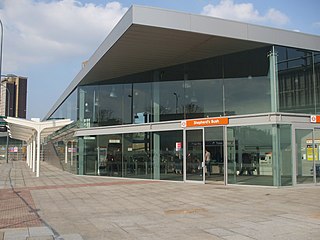
White City is a district of London, England, in the northern part of Shepherd's Bush in the London Borough of Hammersmith and Fulham, 5 miles (8 km) west-northwest of Charing Cross. White City is home to Television Centre, White City Place, Westfield London and Loftus Road, the home stadium of Queens Park Rangers F.C. The district got its name from the white marble cladding used on buildings during several exhibitions when the area was first developed, between 1908 and 1914.

The 1908 Summer Olympics were an international multi-sport event held in London, England, from 27 April to 31 October 1908. The 1908 Games were originally scheduled to be held in Rome, but were relocated on financial grounds following the violent eruption of Mount Vesuvius in 1906, which claimed over 100 lives; Rome eventually hosted the Games in 1960.

Imperial War Museums (IWM), is a British national museum. It is headquartered in London, with five branches in England. Founded as the Imperial War Museum in 1917, it was intended to record the civil and military war effort and sacrifice of the United Kingdom and its Empire during the First World War. The museum's remit has since expanded to include all conflicts in which British or Commonwealth forces have been involved since 1914. As of 2012, the museum aims "to provide for, and to encourage, the study and understanding of the history of modern war and 'wartime experience'."
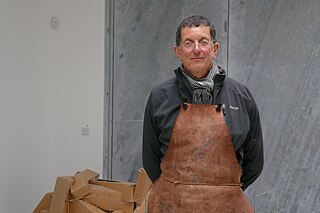
Sir Antony Mark David Gormley is a British sculptor. His works include the Angel of the North, a public sculpture in Gateshead in the north of England, commissioned in 1994 and erected in February 1998; Another Place on Crosby Beach near Liverpool; and Event Horizon, a multipart site installation which premiered in London in 2007, then subsequently in Madison Square in New York City (2010), São Paulo, Brazil (2012), and Hong Kong (2015–16).

Albertopolis is the nickname given to the area centred on Exhibition Road in London, named after Prince Albert, consort of Queen Victoria. It contains many educational and cultural sites. It lies in the former village of Brompton in Middlesex, renamed as South Kensington, split between the Royal Borough of Kensington and Chelsea and the City of Westminster, and the area bordered by Cromwell Road to the south and Kensington Road to the north.

The Franco-British Exhibition was a large public fair held in London between 14 May and 31 October 1908. It was the first in the series of the White City Exhibitions. The exhibition attracted 8 million visitors and celebrated the Entente Cordiale signed in 1904 by the United Kingdom and France. The chief architect of the buildings was John Belcher.

The British Empire Exhibition was a colonial exhibition held at Wembley Park, London England from 23 April to 1 November 1924 and from 9 May to 31 October 1925.

The Japan-British Exhibition of 1910 took place at White City, London in Great Britain from 14 May 1910 to 29 October 1910. It was the largest international exposition that the Empire of Japan had ever participated in and was driven by a desire of Japan to develop a more favorable public image in Britain and Europe following the renewal of the Anglo-Japanese Alliance. It was also hoped that the display of manufactured products would lead to increased Japanese trade with Britain. Japan made a successful effort to display its new status as a great power by emphasizing its new role as a colonial power in Asia.

Earls Court Exhibition Centre was a major international exhibition and events venue in London, England. At its peak it is said to have generated a £2 billion turnover for the economy. It replaced exhibition and entertainment grounds, originally opened in 1887, with an art moderne structure built between 1935 and 1937 by specialist American architect C. Howard Crane. With the active support of London mayor Boris Johnson, in an attempt to create Europe's "largest regeneration scheme", its proposed heritage listing was refused after it was acquired by developers, who promptly in 2008 applied for and were granted a Certificate of Immunity from Listing by English Heritage, and its demolition was completed in 2017.

The Ballets Russes was an itinerant ballet company begun in Paris that performed between 1909 and 1929 throughout Europe and on tours to North and South America. The company never performed in Russia, where the Revolution disrupted society. After its initial Paris season, the company had no formal ties there.

Anna Airy was an English oil painter, pastel artist and etcher. She was one of the first women officially commissioned as a war artist and was recognised as one of the leading women artists of her generation.
Events from the year 1908 in the United Kingdom.
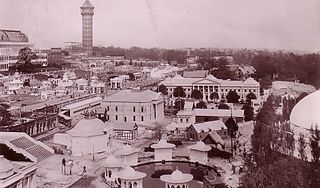
The 1911 Festival of Empire was the biggest single event held at The Crystal Palace in London since its opening. It opened on 12 May and was one of the events to celebrate the coronation of King George V. The original intention had been that Edward VII would open it in 1910, however, this was postponed after his death shortly before the planned opening day. The Festival contained a display of landscapes and exhibits from the British Empire, mainly the dominion countries, to encourage emigration to those nations; and it contained a large scale pageant dramatising British history. It was described at the time as 'a social gathering of the British family' encouraging the 'firmer welding of those invisible bonds which hold together the greatest empire the world has ever known'. It has since been described as the 'ultimate imperialist propaganda showcase'.
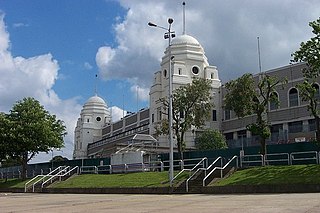
A total of twenty-five sports venues were used to host the events of the 1948 Summer Olympics in London, United Kingdom. For the first time in the history of the modern Olympic Games, the diving, gymnastics, swimming, and water polo competitions were held indoors. These Games have since been nicknamed the "Austerity Games" for the tight control of costs at a time when the host nation was still under rationing, which resulted in a total expenditure of around £750,000. All of the venues were already in place and required only temporary modifications. The organizing committee decided not to build an Olympic Village; instead, foreign athletes were housed in makeshift camps at military bases and colleges around London, while local athletes were told to stay at home. Despite these measures, the combined venues of the 1948 Summer Olympics recorded the highest attendance figures for a Games at that time.
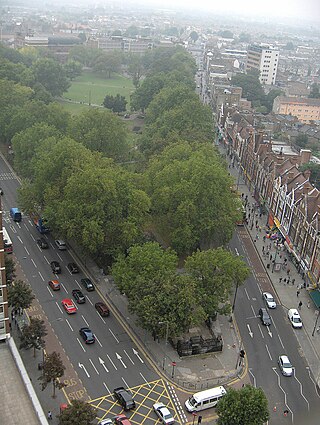
Shepherd's Bush is a neighbourhood in the London Borough of Hammersmith and Fulham centred on Shepherd's Bush Green. Originally a pasture for shepherds on their way to Smithfield market, it was largely developed in the late nineteenth and early twentieth centuries. In 1844 the West London Railway officially opened, followed in 1864 by the Metropolitan Railway who built the original Shepherd's Bush station, opening up the area to residential development. Businesses soon followed, and in 1903 the west side of Shepherd's Bush Green became the home of the Shepherd's Bush Empire, a music hall whose early performers included Charlie Chaplin.

The Imperial Austrian Exhibition world's fair was held at Earl's Court in London in 1906. It opened on 20 June and closed on 6 October.

The history of Imperial College London can be traced back to the founding of the Royal College of Chemistry in 1845 in London, with some ancestral medical schools dating back to 1823. The college was formed in 1907 out of the royal colleges in South Kensington, and throughout the 20th century became central to the national strategy for technical education and research. It existed for most of its life as part of the University of London, only becoming independent in 2007.
References
- ↑ "Entrance to Hipp Sport History 2 White City 1908 Olympics" (PDF). HistoryTalk.org. Archived from the original (PDF) on 11 March 2012. Retrieved 29 January 2017.
- ↑ "28 May 1909 - IMPERIAL EXHIBITION. AUSTRALIAN WOMEN'S WORK. LO..." Argus (Melbourne, Vic. : 1848 - 1957). 28 May 1909. p. 8. Retrieved 31 March 2012.
- 1 2 3 "Papers Past — Poverty Bay Herald — 22 May 1909 — IMPERIAL EXHIBITION" . Retrieved 31 March 2012.
- 1 2 3 "White City Exhibitions - Exploring 20th Century London". Archived from the original on 23 August 2010. Retrieved 30 July 2010.